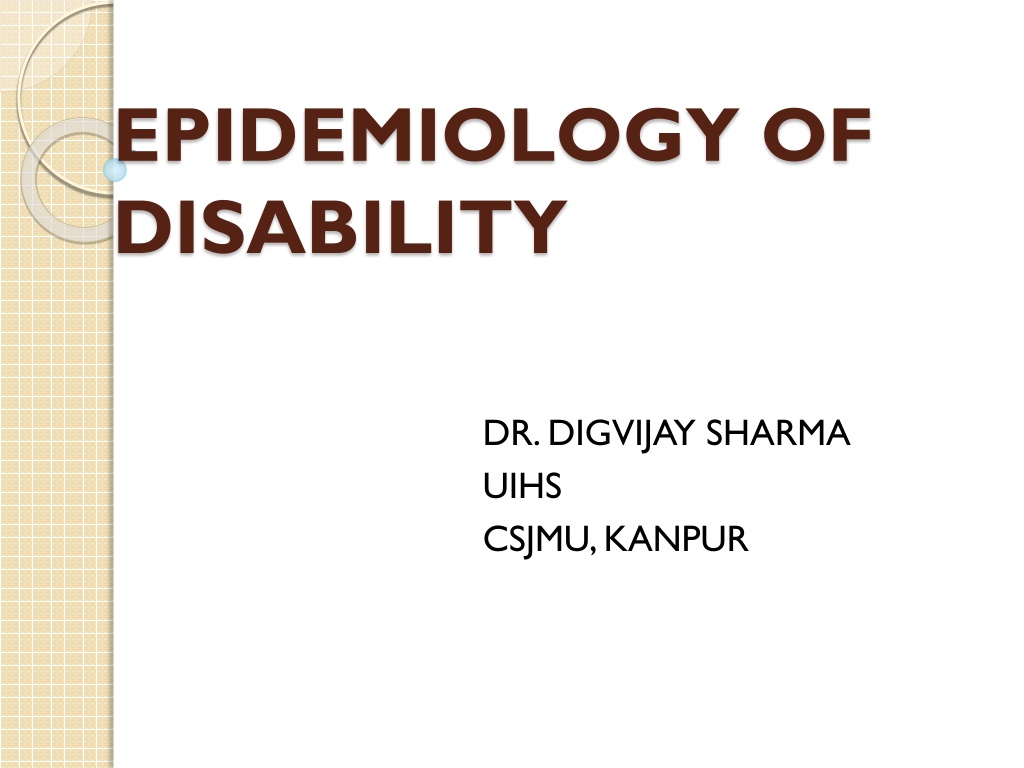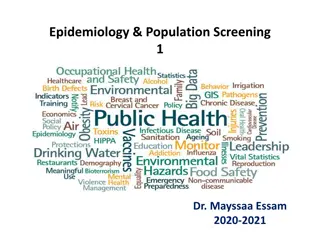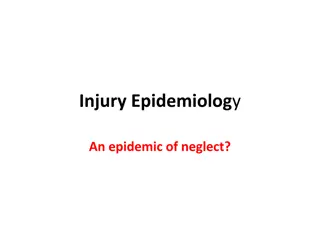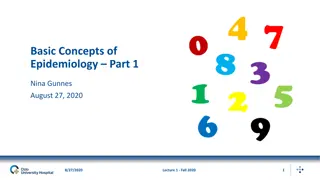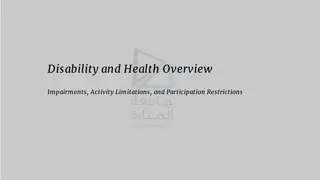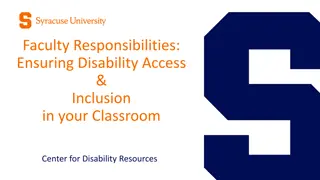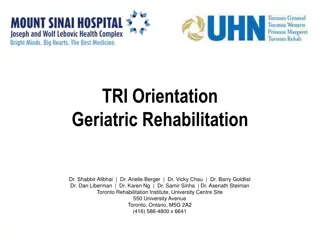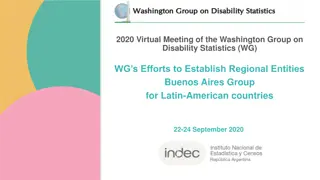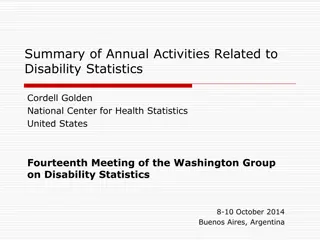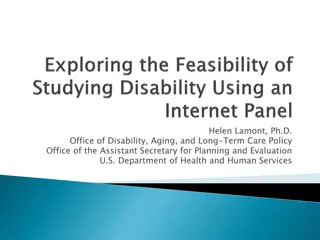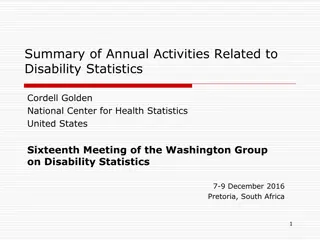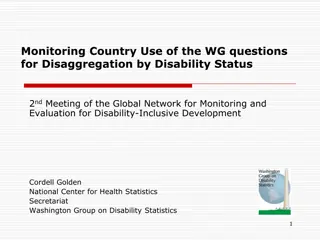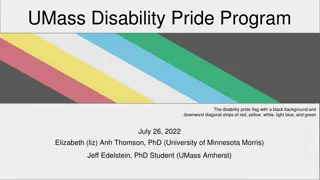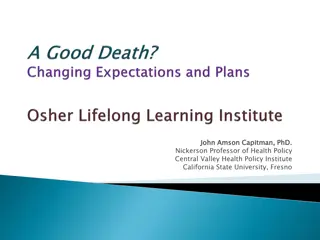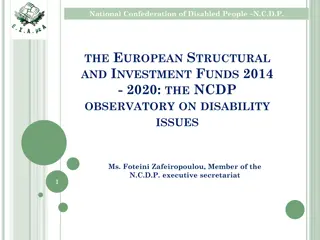Understanding the Epidemiology of Disability and Its Impact on Health
Epidemiology focuses on studying disease causes, prevention, and control. Impairment, disability, and handicap are defined by the WHO. Impairment refers to loss or abnormality of function, disability refers to limitations in normal activities due to impairment, and handicap indicates social disadvantages resulting from impairment or disability. Factors like age, sex, and socio-economic background play a role in determining handicap. Impairment may not always lead to disability, and the relationship among impairment, disability, and handicap is intricate.
Download Presentation

Please find below an Image/Link to download the presentation.
The content on the website is provided AS IS for your information and personal use only. It may not be sold, licensed, or shared on other websites without obtaining consent from the author. Download presentation by click this link. If you encounter any issues during the download, it is possible that the publisher has removed the file from their server.
E N D
Presentation Transcript
EPIDEMIOLOGY OF DISABILITY DR. DIGVIJAY SHARMA UIHS CSJMU, KANPUR
EPIDEMIOLOGY The word epidemiology is derived from the Greek word epidemios; meaning on the people It is concerned with the study of the factors causing disease and the means to prevent or eradicate it. Epidemiology is the study of the distribution and determinants of health related states or events(including disease), and the application of this study to the control of diseases and other health problems. In the early 20th century, CO Stallybross defined epidemiology as the science which considers infectious disease their course, propagation and prevention.
IMPAIRMENT, DISABILITY AND HANDICAP The(WHO)World Health Organization s International Classification of Impairments, Disabilities and Handicaps (ICIDH 1980) defines these terms as follows: Impairment: Any loss or abnormality of psychological, physiological, or anatomical structure or function. For example- the loss of a finger, loss of conduction of impulses in the heart, or loss of certain chemicals in the brain leading to Parkinsonism. Not all impairments lead to disability; For example- the loss of the pinna of the ear, an impairment, would not lead to loss of hearing but merely a cosmetic deficiency.However, a road accident leading to brain injury can lead to gross disability with multiple handicaps.
Disability: Any restriction or lack of ability to perform an activity in the manner or within the range considered normal for a human being resulting from impairment. e.g. difficulty in walking after lower limb amputation. It must be noted here that strenuous or rarely indulged in feats like rock climbing or wind surfing are not included in activities to be considered for disability. To be considered disabled a person should not be able to perform day to day activities considered normal for his age, sex or physique.
Handicap: A disadvantage for a given individual in his or her social context resulting from impairment or a disability that limits or prevents the fulfillment of a role that is normal for him or her. This depends on the age, sex, social and cultural factors for that individual. Many socioeconomic factors like family background, skills achieved and financial stability come into play while determining handicap. Various governments all over the world have recognized the social impact of handicap and are more inclusive in their approach.
Impairment is a manifestation of a problem at the tissue or organ level, Disability, at the level of the individual, while Handicap in the translation of the problem at the societal level. Example, inability to walk due to polio, a disability, may lead to muscle weakness and contractures, which are impairments. Not every impairment leads to disability. The relation between these three concepts of impairment, disability and handicap is very subtle, and can best be illustrated by examples. If a person has lost a leg, the loss of the leg is the impairment. The disability would be inability to perform all activities related to the leg, primarily walking. The handicap would relate this disability to the person s role in society, and for the same disability, i.e. inability to walk, the handicap would vary according to the person s economic background, job and distance that he would need to walk everyday.
Relationship between Impairment Disability and Handicap Impairment Disability and Handicap: Their impact at various levels affecting the organ, the person and society as a whole
Primary and Secondary Disabilities Disabilities that are direct consequences of a disease or condition are called primary disabilities. Paraplegia following spinal cord injury or inability to walk following hip fracture are examples of primary disability. On the other hand, disabilities that did not exist at the onset of the primary disability but develop subsequently are called secondary disabilities.
Secondary disability is indirectly related to the disease or condition that is responsible for the primary disability. Examples are joint contracture in poliomyelitis, subluxation of shoulder joint in hemiplegia, tendo-Achilles contracture in cerebral palsy and pressure sores in paraplegia.
Vicious cycle of inactivity and immobilisation due to disability leading to increase of morbidity and thence to secondary disabilty.
Multiple Disabilities About 12 percent of individuals with disability suffer from more than one type of disability. For example, a child with cerebral palsy would probably have, in addition to the delayed milestones and motor problems, damage of the part of the brain responsible for sight and hearing. In addition it may have mental sub normality. As a consequence to these impairments, it may display temper tantrums and not cooperate with the therapist.
The EconomicImpact Every year, several crores of rupees are spent on maintaining disabled people. If they are rehabilitated to a level of self-dependence, there is a tremendous saving to the national exchequer. The economics also can be gauged by the fact that successful rehabilitation sets free the able- bodied person taking care of his disabled relative. It is often said that a handicapped individual means a handicapped family, since most of the resources, time and efforts of the family members go into his maintenance.
Handicaps The WHO has identified six handicaps: 1. Locomotor handicap (which forms 60 percent of all handicaps), 2. Visual handicap 3. Hearing and speech handicap 4. Cardiopulmonary handicap 5. Intellectual handicap and 6. Emotionally disturbed Many patients suffer from multiple handicaps, which include combinations of any of the six given above.
Diagnosis of Disability All specialties in therapeutic medicine require early and precise diagnosis in order to institute the most effective treatment. The same logic applies to rehabilitation, and the disabled should be given early evaluation and intensive treatment to prevent permanent disability. The total person, physically, emotionally, vocationally and socially, must be considered in the diagnosis.The patient is evaluated as a human being and not as a case . Patients with multiple disabilities need to be handled sensitively. Diagnosis of disability may be expressed either in terms of the amount of disability (disability evaluation) or in terms of the amount of remaining function (functional diagnosis).
Disability Evaluation Disability Evaluation is the quantification of the residual lack of ability of the individual to carry out his day to day activities. It is individualized and is subject to several factors. The disability evaluation is done for: 1.Visual Impairment 2.Locomotor Handicap 3.Mental Retardation 4.Hearing and speech 5.Multiple disabilities The WHO has classified disability in relation to physical and social function. Disability may also be classified as temporary or permanent. A board duly constituted by the Central and State Governments is authorised to certify disability. There should be atleast three members out of which atleast one is a specialist to assess physical, visual or speech and hearing. As per the MEDICAL COUNCIL OF INDIA , only a medical doctor registered under the first schedule of MCI Act 1950 can issue the physical impairment certificate .
The certificate of permanent disability is issued by a board deputed by the Central and State Governments. It consists of the Chief Medical Officer in the district, or the director of a major governmental institution working for the cause of rehabilitation and other experts in the specified field as follows: Ophthalmologist visual handicap ENT Surgeon speech and hearing handicap Orthopedic surgeon or physiatrist locomotor handicap Psychiatrist/clinical psychologist or special educator mental handicap Cardiologist/chest physician cardiopulmonary handicap Sometimes a board consisting of more than one specialist may be needed to evaluate multiple disabilities. The certificate form is valid for 5 years for those classified as temporary, and for those with permanent disability , it is stamped as permanent.
Functional Diagnosis The diagnosis of the condition of the patient when he comes in to rehabilitation is usually known, but the amount of remaining function is not. Rehabilitation professionals are trained to arrive at a functional diagnosis to evaluate the residual capabilities of the individual and strengthen them. The functional diagnosis should be: Objective, using measurable factors so that the results are statistically more reliable. Descriptive so that the actual situation is accurately reflected. Simple enough so that rapid evaluation is possible. Reproduced, so that constancy may be maintained. Comprehensive, so that the diagnosis is complete and specifically utilized in the direct care of the patients and is relevant for epidemiological investigation. Standarized scales such as BARTHEL INDEX or the functional independence measure , (FIM) Are used to quantify the extent of functions.
Disability Limitation The role of medical rehabilitation is disability limitation. Disability limitation refers to preventing an increase in the intensity or scope of an existing disability. This measure, therefore, becomes necessary after termination of active medical or surgical treatment. For example, a patient with stroke admitted under a neurologist during the acute phase, which ensures that he survives the stroke. When he or she gets discharged from hospital, he needs to be taken through the recovery phase. This may take weeks or months.
CONSTITUTIONAL RESPONSIBILITIES IN INDIA The State shall strive to promote the welfare of the people by securing and protecting as effectively as it may, a social order in which justice social, economic and political, shall be delivered. The State shall, within the limits of its economic capacity and development make effective provisions for securing the right to work, education and to public assistance in cases of unemployment, old age, sickness and disablement and in other cases of want. The objective of social welfare is to secure for each human being the economic necessities, a decent standard of health and living conditions and equal opportunities with his fellow citizens . Rehabilitation is primarily the responsibility of the state. It is not a matter of charity but a matter of right.
The Rights of Persons with Disabilities Act-- India is a signatory to the Convention on the Rights of Persons with Disabilities adopted by the United Nations General Assembly in 2006. After much debate, the Rights of Persons with DisabilitiesAct, 2016 was passed based on the inherent tenets of the convention which are- Respect for dignity, inividual autonomy and independence of persons. Non discrimination Full and effective participation and inclusion in society.
Respect for difference and acceptance of persons with disabilities as part of human diversity and humanity. Equality of opportunity Accessibility Equality between men and women Respect for the evolving capacities of capacities with disabilities.(Source:The Gazette of India December 2016)
In The Rights of Persons with Disabilities Act 2016, 16 chapters are laid out dealing with- Rights and entitlements Education Skill developments and employments Social security, health, rehabilitation and recreation Special provisions for persons with benchmark disabilities Special provisions for persons with disabilities with high support needs Duties and responsibilities of appropriate governments Registration of institutions for persons with disabilities and grant for such institutions
Certification of specified disabilities Central and State advisory board on disability and district level committee Chief commissioner and state commissioner for person with disabilitites State fund for person with disabilities National fund for person with disabilities Special court Offence and penalties related to disabilities Miscellaneous
OTHER SCHEMES National Institutes National Institute for the visually handicapped Dehradun National Institute for the orthopaedically handicapped Calcutta Ali Yavar Jung National Institute for the hearing handicapped Bombay National Institute for the mentally handicapped Secunderabad The above four institutes provide a complete package of welfare services. Other Institutes Institute for the Physically Handicapped (IPH) New Delhi National Institute of Rehabilitation, Training and Research (NIRTAR) Bairoi Cuttack Government Institutes of Rehabilitation medicine in Chennai, Trivandrum, Jaipur, and other states. National Institute of Mental Health and Neurological Sciences NIMHANS, Bangalore.
Artificial Limbs Manufacturing Corporation (ALIMCO)- ALIMCO was established in 1972 in Kanpur with the objective of promoting, developing, manufacturing and marketing of artificial limbs, aids and appliances. District Rehabilitation Centre Scheme (DRC)- Operates in eleven different parts of the country. This scheme provides services for all persons with disability. Rehabilitation Council of India (RCI)- This is to enforce uniform standards in training of professionals in the field of rehabilitation, maintenance of central rehabilitation register and other related matters. INCOME TAX CONCESSIONS- A deduction from the taxable income of the parents/guardians of handicapped children has been allowed provided this amount is deposited in any approved scheme of LIC, UTI, etc. The deductions vary from year to year.
National Institute for Empowerment of Persons with Multiple Disabilities (NIEPMD) was established in the year 2005 in Chennai to cater for persons with cerebral palsy, traumatic brain injury and such conditions where multiple disabilities are present in the same person.
To cater to persons with autism and mental retardation the following schemes were launched: 1. DISHA(Early intervention and school readiness Scheme) 2. BADHTE KADAM(Awareness and community interaction) 3. GHARAUNDA(Group home for adults) 4. NIRAMAYA(Health insurance scheme) 5. SAMBHAV(Aids and assisted devices) 6. SAHYOGI(Caregiver training scheme) 7. GYAN PRABHA(Educational support) 8. PRERNA(Marketing assistance) 9. SAMARTH(Respite care) 10. VIKAAS(day care)
Grades of Disability Mild less than 40 percent Moderate 40 percent and above Severe 75 percent and above Profound 100 percent For all concessions eligibility for the certificate is only for those with 40 percent and above. Persons suffering from cardiopulmonary handicaps are not eligible in reservation of jobs. UDID unique disability Id : This card is under department of empowerment of persons with disabilities, ministry of social justice and empowerment, government of India.
UNIQUE DISABILITY ID UDID or unique ID for person with disabilities ,project is being implemented with a view of creating a national data base for PWDs. This card encourage transparency ,effeciency and ease of delivering the govt. benefit to the person with diasabilities.
